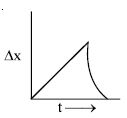Two stones are thrown up vertically and simultaneously but with different speeds. Which graph correctly represents the time variation of their relative positions $\Delta x$.Assume that stones do not bounce after hitting ground.
Two stones are thrown up vertically and simultaneously but with different speeds. Which graph correctly represents the time variation of their relative positions $\Delta x$.Assume that stones do not bounce after hitting ground.
- A

- B

- C

- D

Similar Questions
A particle starts from rest and performing circular motion of constant radius with speed given by $v = \alpha \sqrt x$ where $\alpha$ is a constant and $x$ is the distance covered. The correct graph of magnitude of its tangential acceleration $(a_t)$ and centripetal acceleration $(a_c)$ versus $t$ will be:
A particle starts from rest and performing circular motion of constant radius with speed given by $v = \alpha \sqrt x$ where $\alpha$ is a constant and $x$ is the distance covered. The correct graph of magnitude of its tangential acceleration $(a_t)$ and centripetal acceleration $(a_c)$ versus $t$ will be:
If a particle takes $t$ second less and acquires a velocity of $v \ ms^{^{-1}}$ more in falling through the same distance (starting from rest) on two planets where the accelerations due to gravity are $2 \,\, g$ and $8 \,\,g$ respectively then $v=$
If a particle takes $t$ second less and acquires a velocity of $v \ ms^{^{-1}}$ more in falling through the same distance (starting from rest) on two planets where the accelerations due to gravity are $2 \,\, g$ and $8 \,\,g$ respectively then $v=$
A rigid rod is sliding. At some instant position of the rod is as shown in the figure. End $A$ has constant velocity $v_0$. At $t = 0, y = l$ .
A rigid rod is sliding. At some instant position of the rod is as shown in the figure. End $A$ has constant velocity $v_0$. At $t = 0, y = l$ .
At time $t =0$ a particle starts travelling from a height $7\,\hat{z} cm$ in a plane keeping $z$ coordinate constant. At any instant of time it's position along the $x$ and $y$ directions are defined as $3\,t$ and $5\,t^{3}$ respectively. At $t =1\,s$ acceleration of the particle will be.
At time $t =0$ a particle starts travelling from a height $7\,\hat{z} cm$ in a plane keeping $z$ coordinate constant. At any instant of time it's position along the $x$ and $y$ directions are defined as $3\,t$ and $5\,t^{3}$ respectively. At $t =1\,s$ acceleration of the particle will be.
- [JEE MAIN 2022]
For any arbitrary motion in space, which of the following relations are true
$(a)$ $\left. v _{\text {average }}=(1 / 2) \text { (v }\left(t_{1}\right)+ v \left(t_{2}\right)\right)$
$(b)$ $v _{\text {average }}=\left[ r \left(t_{2}\right)- r \left(t_{1}\right)\right] /\left(t_{2}-t_{1}\right)$
$(c)$ $v (t)= v (0)+ a t$
$(d)$ $r (t)= r (0)+ v (0) t+(1 / 2)$ a $t^{2}$
$(e)$ $a _{\text {merage }}=\left[ v \left(t_{2}\right)- v \left(t_{1}\right)\right] /\left(t_{2}-t_{1}\right)$
(The 'average' stands for average of the quantity over the time interval $t_{1}$ to $t_{2}$ )
For any arbitrary motion in space, which of the following relations are true
$(a)$ $\left. v _{\text {average }}=(1 / 2) \text { (v }\left(t_{1}\right)+ v \left(t_{2}\right)\right)$
$(b)$ $v _{\text {average }}=\left[ r \left(t_{2}\right)- r \left(t_{1}\right)\right] /\left(t_{2}-t_{1}\right)$
$(c)$ $v (t)= v (0)+ a t$
$(d)$ $r (t)= r (0)+ v (0) t+(1 / 2)$ a $t^{2}$
$(e)$ $a _{\text {merage }}=\left[ v \left(t_{2}\right)- v \left(t_{1}\right)\right] /\left(t_{2}-t_{1}\right)$
(The 'average' stands for average of the quantity over the time interval $t_{1}$ to $t_{2}$ )
